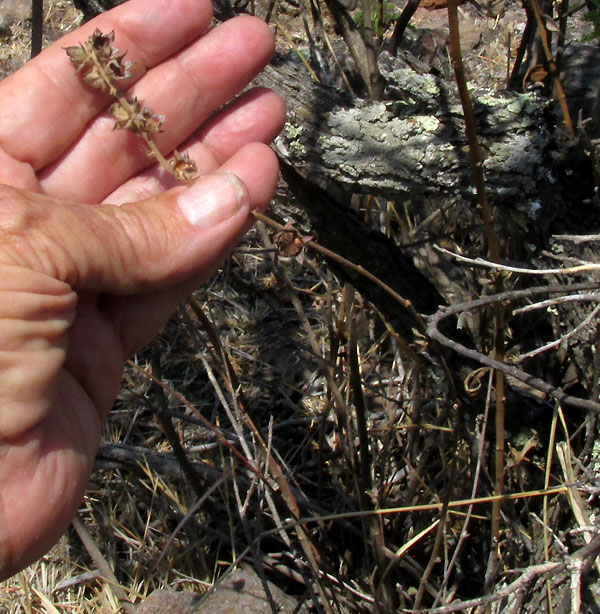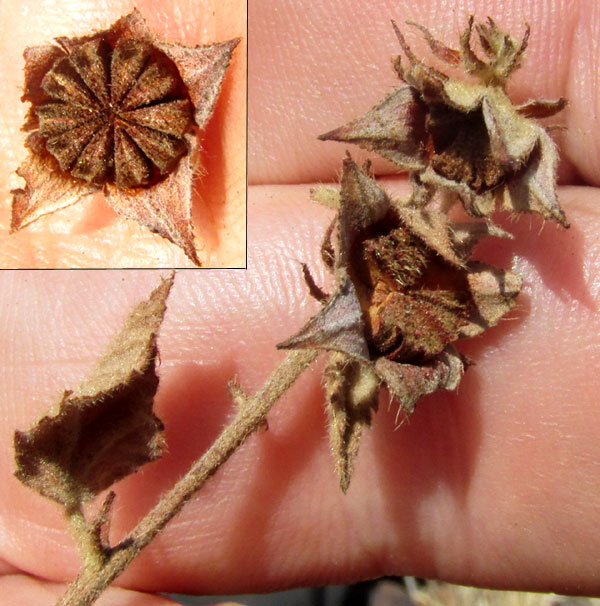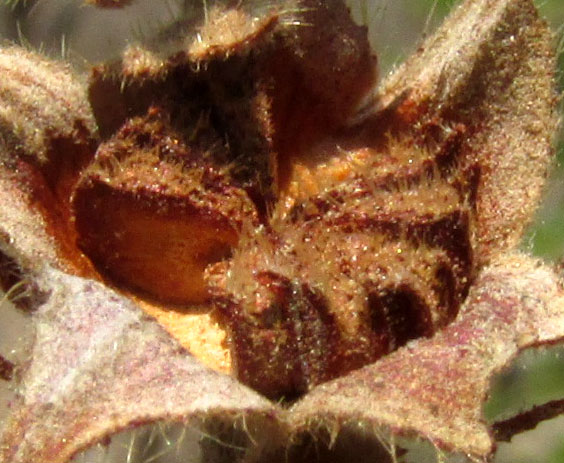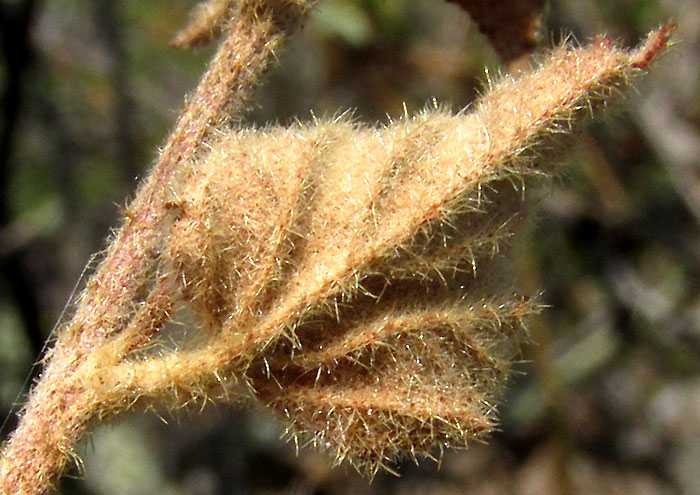Excerpts from Jim Conrad's
Naturalist Newsletter
entry dated April 6, 2023, with notes from the lower slope of hill south of El Cerrito, 5kms south of Tequisquiapan; bedrock volcanic andesite, an intermediate rock between basalt and rhyolite; elevation about 2,000m (6600 ft), Querétaro state, MÉXICO
(~N20.47°, ~W99.89°)
DESERT FALSE MALLOW

On a grossly overgrazed, eroded lower slope of the ridge south of El Cerrito, the above dead, dry-season crisp, semiwoody stem a little less than knee high stood among rocks and weeds at the very base of a low-branching mesquite, Prosopis laevigata. Usually such leafless, weedy remnants are hard to identify, but in the above picture notice the star-shaped item on the stem, just below my thumb. That's a calyx enveloping a special kind of fruit unmistakably announcing that this plant is a member of the big Hibiscus Family, the Malvaceae. In this family, the most important identification features very often are seen on the fruits, which develop into various remarkable forms and variations, from cotton bolls to okra. Here's a closer look at this plant's fruits:

Above,the inset shows a flat-topped, pie-like, schizocarp-type fruit, typical of numerous Hibiscus Family genera. Schizocarps are dry fruits which when mature split into single-seeded sections called mericarps. The five star-arms surrounding the schizocarp are calyx lobes. The rest of the above picture shows two fruits attached to the stem, and below them, a dried-out leaf not as large as the main leaves, which have fallen off. The small leaf indicates that the blade is longer than wide, bears low teeth along the margins, and the blade tip is sharp, not rounded. Below you see something important the fruit does:

It's like a chocolate cake with a few slices missing. The whole cake is the schizocarp, and the cut slices are mericarps. Each mericarp contains one seed, so when a mericarp falls from the schizocarp, seed dispersal takes place. One feature seen above important for identification is that in this species the walls between the mericarps disintegrate, enabling the mericarps to fall out individually. One variation on the schizocarp theme is that in some genera the mericarps stay put, but split to release their seeds individually, as shown on our Narrowleaf Globemallow page. Another necessary observation for identification to species level is that each mericarp, atop its outside face, bears two pointed "teeth." In the above picture, that's best seen on the fruit's far right. Below, more important field marks are on display:

That's the lower side of a fruit's calyx. Notice the slender, shoehorn-like item emerging from the calyx's base. That's one of three or four modified leaves called bractlets. Many genera of the Hibiscus Family don't produce such bractlets, while others do, sometimes conspicuously, as on Fairy Hibiscus flowers. Also, this plant's hairiness is special. In the above picture, at the image's very bottom and on the slanting stem, note what appears to be tiny, roundish, silvery scales with dark centers, and the scales are fringed with short, thick hairs. This is a special kind of "stellate hair," stellate meaning star-like. Technical descriptions describe two kinds of stellate stem hairs on this species: larger ones usually with 5 hairs, and; smaller ones with 4-8. Leaves and calyxes develop a mixture of long, simple hairs, sometimes tufted, rising above the stellate hairs. All these hair details are helpful for identifying to species level. Finally, here's the hairy lower surface of a small, dead leaf:

In our area, if you have an erect-standing Hibiscus Family member whose blossoms are immediately subtended by two or three slender bractlets, but not more, and the leaves are 1.5 to 2 times longer than wide, but not over 8cm long (3 inches), you have a species of false mallow, genus Malvastrum. It's "false" because it's not a "real" mallow, of which there are numerous species in several closely related genera, the "classic" mallow genus being Malva, such as is the Cheeseweed, Malva parviflora.
This false and real business is a matter of fossil names from the time of the early English-rooted name givers. When they saw something almost but not quite like what they remembered from England, they were "false" ... false lily of the valley, false indigo, false hellebore, false Solomon's seal. Even taxonomists can think like this. The name Malvastrum derives from the mallow genus Malva and the Latin -astrum, which means "incomplete resemblance."
In our area, if you have a false mallow, genus Malvastrum, with its schizocarp mericarps bearing two tooth-like points atop their outside face, and flowers arranged within the raceme-type inflorescence sometimes spaced well away from other flowers, you have MALVASTRUM BICUSPIDATUM. The species occurs in dry grasslands and tropical deciduous forests (here in mesquite thickets), from Arizona in the US south into Oaxaca, southern Mexico.
Malvastrum bicuspidatum in English mostly is known as Sonoran Desert False Mallow, because in the US it's limited to the Sonoran Desert. However, this is overwhelmingly a Mexican species occurring beyond the Sonoran Desert, so here we'll drop the Sonoran part of the name. The species is divided into four subspecies, of which ours is ssp. campanulatum. If you look on the Internet for pictures of the species' schizocarps, most images are of US plants, and on those it's interesting to see how the mericarp teeth are so much longer and slenderer than ours, and the flowers cluster together on the stem much closer.
This plant has been little studied and, beyond being listed as present in different localities, hardly any information about it is available. I can say that, typical of members of the Hibiscus Family, the slender stems contain surprisingly strong fibers. If, using your thumbnail, you try to snip off a dead flowering head to photograph the fruits, it's likely the thumbnail will break, not the stem.